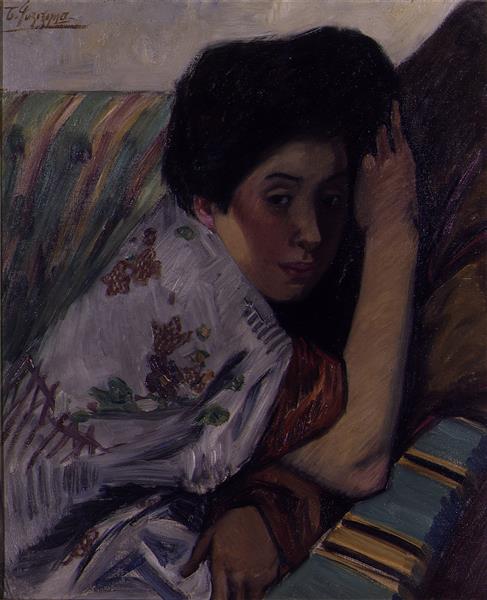Beskrivelse
Fujishima Takeji, a leading Japanese painter of the Nihonga movement, captures the essence of an ethereal world in his work “Half Dreaming – 1913”. In this canvas, the fusion between Japanese tradition and Western modernity is manifested through a composition that evokes a delicate balance between tangible reality and the dreamlike realm. The work reflects both the artist’s technical skill and his deep understanding of human psychology and cultural influences on the perception of dreaming.
Visually, the painting is structured around a central theme that invites the viewer to introspect on the duality of being. The female figure, who is in a relaxed and contemplative posture, seems to be in a dreamlike state. Her features are ideal, typical of the Japanese aesthetic style, with a serene face that radiates an almost transcendental calm. This female character, often interpreted as a representation of beauty and vulnerability, symbolizes the connection between the physical and the spiritual.
The use of color in “Half Dreaming” is especially notable. Fujishima employs a soft palette that includes pastel tones and delicate hues, which contributes to the ethereal atmosphere of the work. The blue and green hues that dominate the background suggest a sense of serenity, while hints of pink and lavender in the figure’s clothing add an element of sensuality and dreams. This color choice not only establishes the emotional state of the work, but also places the viewer in an almost magical environment.
The texture and technique of the painting are equally relevant. Fujishima Takeji is known for his mastery of traditional Japanese painting techniques, which are fused in this work with influences from Western Impressionism and Post-Impressionism. The softness of the brush and attention to detail can be appreciated in the way the light interacts with the surface of the figure, creating an enveloping and almost palpable atmosphere. This technical mastery is a testament to Fujishima’s deep understanding not only of painting, but also of the psychology of color and light.
An interesting aspect of “Half Dreaming” is its historical context. Painted in 1913, the work was produced during a period when Japan was undergoing a process of modernization and cultural opening to the West, which undoubtedly influenced the evolution of Fujishima’s style. While traditional Nihonga focused on ancient themes and techniques, this work reflects a transition to a more contemporary interpretation that celebrates both Japanese identity and global influence. Thus, Fujishima becomes a bridge between ancient traditions and new artistic currents.
Fujishima Takeji’s art, and “Half Dreaming” in particular, continues to resonate with modern audiences, not only for its aesthetic beauty, but also for its thematic depth. The work invites us to reflect on the intermediate states of consciousness, where the boundaries between dream and wakefulness blur and new possibilities for interpretation emerge. This multilayered approach, simultaneously revealing and concealing, makes the experience of viewing this painting both enriching and provocative. Thus, “Half Dreaming” establishes itself not only as a masterpiece of Japanese painting, but as a powerful symbol of the dialogue between tradition and modernity, reality and fantasy.
KUADROS ©, a famous painting on your wall.
Hand-made oil painting reproductions, with the quality of professional artists and the distinctive seal of KUADROS ©.
Painting reproduction service with satisfaction guarantee. If you are not completely satisfied with the replica of your painting, we will refund 100% of your money.

